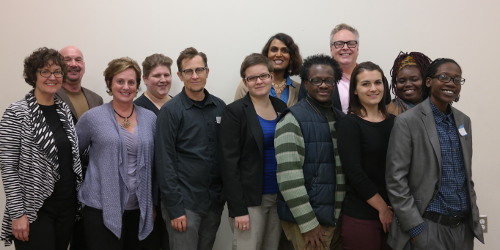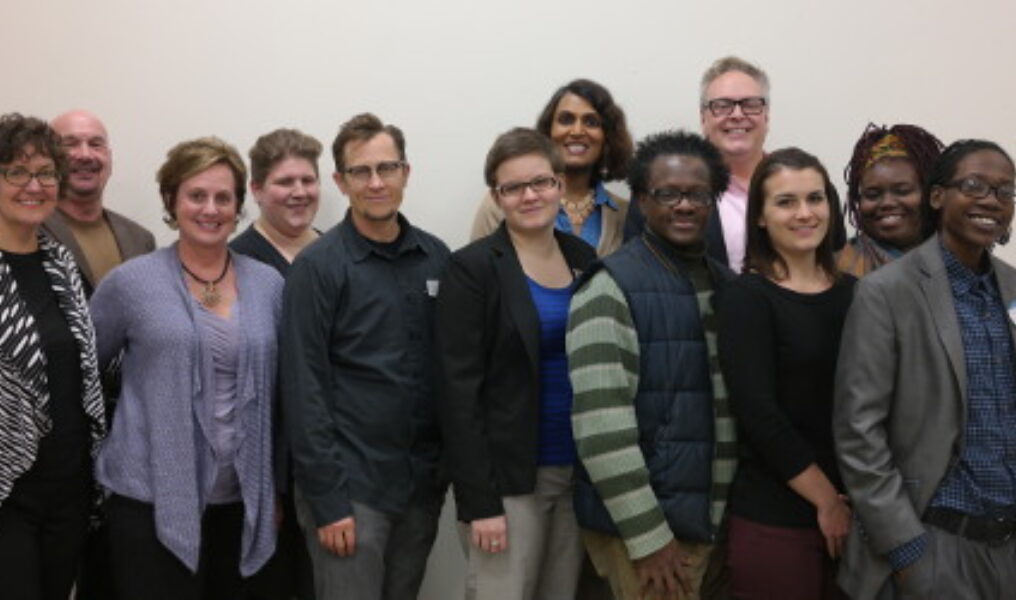BY AJ TRAGER

Members from the Michigan Department of Community Health, Perceptions, the Kalamazoo Gay and Lesbian Resource Center, KICK, LGBT HealthLink, Affirmations and The Network gathered for the official release of the report on Dec. 3. Dr. Scout, (fifth from the left) presented his preliminary findings on smoking rates for the LGBT community that same day but will release the full report at a later time. BTL Photo: AJ Trager
Members from the Michigan Department of Community Health, Perceptions, the Kalamazoo Gay and Lesbian Resource Center, KICK, LGBT HealthLink, Affirmations and The Network gathered for the official release of the report on Dec. 3. Dr. Scout, (fifth from the left) presented his preliminary findings on smoking rates for the LGBT community that same day but will release the full report at a later time. BTL Photo: AJ Trager
FERNDALE – In collaboration with the Michigan Department of Community Health (MDCH), Perceptions in Saginaw and the Kalamazoo Gay and Lesbian Resource Center (KGLRC), Affirmations officially released its study on smoking rates among LGBT individuals in Michigan and how effective the marketing is to the LGBT clientele.
The official report showcases that smoking rates amongst the LGBT community in Michigan remain significantly higher than rates for the state at large.
In 2013, MDCH provided funding for the three community centers to host focus group interviews to discuss the effectiveness of anti-tobacco campaigns, policies and treatment services. Intern at Affirmations and University of Michigan student, Hilary Armstrong, analyzed the focus group data collected and found that most participants started using tobacco between the ages of 13-18 and use is most most commonly motivated by family and/or social pressure.
An overwhelming number of participants shared the same sentiment of fear and harassment, voicing: "I wanted to smoke because I got tired of being called a sissy. I got tired; I was one of those kids that you could tell from the time I was walking (that) I was really feminine. So I got picked on. I got called names. So I started smoking just so I could look tough."
The study confirmed that LGBT living in Michigan smoke at a higher rate than the nation's average even though every participant reported attempting to quit at least once or feeling a desire to quit. Influence from friends, family or a significant other was a big motivator to quit. And many, when talking about the consequences of smoking, focused on the short term benefits of quitting.
"The things that really came up a lot were things like shortness of breath, wheezing or parking a couple of blocks away and walking to work, being out of breath and not being able to live life the way they'd like to," Armstrong said.
The 48 participants cited a variety of different methods to quit including prescription drugs and nicotine replacement therapy. The amount of success each participant reported was directly related to how many negative side effects they encountered.
Awareness of the Michigan Quit line was consistently low, and for those that did hear about it, many were reluctant to utilize the service. One of the main critiques involved callers feeling they couldn't establish a trusting relationship with those on the other end of the line, fearful that the other person would not be an ally of the LGBT community.
Participants were asked to look at various tobacco campaign advertisements and rate how affected they were, positively or negatively. Some participants reported not trusting a CDC advertisement but regarding ads put out by LGBT organizations much more seriously; these public service announcements were seen as more accepting.
"These policies, that have been recommended at a nationwide level and have been shown to be affected at that level, really could also be feasible and effective within the context of southeastern Michigan as well," Armstrong suggested.
The recommendations include: addressing tobacco industry targeting of the LGBT community; expanding tobacco-free laws to include electronic cigarettes and smoking in casinos; encouraging schools and community centers to host parent-child tobacco prevention education workshops; supporting employers and insurance companies in increasing the cost differential in health insurance premiums for smokers and non-smokers; expanding employer coverage for tobacco cessation counseling programs; increasing the visibility of LGBT-friendly and affirming spaces that do not involve substance use; establishing and promoting tobacco cessation support groups for LGBT communities; promoting Michigan Quit Line as LGBT-friendly and affirming; expanding public insurance coverage of tobacco cessation programs; and improving data collection on sexual orientation and gender identity in health surveys.
The study did have some limitations. The geographic diversity was limited because participants all reside in the southern half of the Lower Peninsula; all focus groups were conducted in English, thus alienating any non-English speaking LGBT; the focus groups were held in LGBT centers, thus individuals living in rural communities were underrepresented; and the recruitment for participation was done online via Facebook and email lists, so individuals without internet access were also left out of the study.










